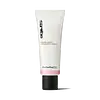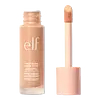What's inside
What's inside
 Key Ingredients
Key Ingredients

 Benefits
Benefits

 Concerns
Concerns

 Ingredients Side-by-side
Ingredients Side-by-side

Water
Skin ConditioningDimethicone
EmollientButylene Glycol
HumectantCetyl Ricinoleate
EmollientGlyceryl Distearate
EmollientTrisiloxane
Skin ConditioningGlyceryl Stearate Se
EmulsifyingCholesterol
EmollientSteareth-10
EmulsifyingSimmondsia Chinensis Seed Oil
EmollientCetyl Esters
EmollientCetyl Alcohol
EmollientTocopheryl Acetate
AntioxidantSodium Hyaluronate
HumectantCamellia Sinensis Leaf Extract
AntimicrobialMorus Bombycis Root Extract
Skin ConditioningPyrus Malus Fruit Extract
Skin ConditioningScutellaria Baicalensis Root Extract
AstringentVitis Vinifera Fruit Extract
Skin ConditioningCeramide Ng
Skin ConditioningCyanocobalamin
Skin ConditioningGlycerin
HumectantIsohexadecane
EmollientSilica
AbrasiveTin Oxide
AbrasiveSucrose
HumectantPolysorbate 80
EmulsifyingSorbitan Oleate
EmulsifyingAcrylamide/Sodium Acryloyldimethyltaurate Copolymer
Emulsion StabilisingXanthan Gum
EmulsifyingCaprylyl Glycol
EmollientHexylene Glycol
EmulsifyingCitric Acid
BufferingLinoleic Acid
CleansingPanthenol
Skin ConditioningParfum
MaskingMagnesium Ascorbyl Phosphate
AntioxidantSodium Metabisulfite
AntioxidantSodium Sulfite
PreservativeSodium Citrate
BufferingDisodium EDTA
Phenoxyethanol
PreservativeMica
Cosmetic ColorantCI 77891
Cosmetic ColorantCI 14700
Cosmetic ColorantWater, Dimethicone, Butylene Glycol, Cetyl Ricinoleate, Glyceryl Distearate, Trisiloxane, Glyceryl Stearate Se, Cholesterol, Steareth-10, Simmondsia Chinensis Seed Oil, Cetyl Esters, Cetyl Alcohol, Tocopheryl Acetate, Sodium Hyaluronate, Camellia Sinensis Leaf Extract, Morus Bombycis Root Extract, Pyrus Malus Fruit Extract, Scutellaria Baicalensis Root Extract, Vitis Vinifera Fruit Extract, Ceramide Ng, Cyanocobalamin, Glycerin, Isohexadecane, Silica, Tin Oxide, Sucrose, Polysorbate 80, Sorbitan Oleate, Acrylamide/Sodium Acryloyldimethyltaurate Copolymer, Xanthan Gum, Caprylyl Glycol, Hexylene Glycol, Citric Acid, Linoleic Acid, Panthenol, Parfum, Magnesium Ascorbyl Phosphate, Sodium Metabisulfite, Sodium Sulfite, Sodium Citrate, Disodium EDTA, Phenoxyethanol, Mica, CI 77891, CI 14700
Water
Skin ConditioningHydrogenated Didecene
Skin ConditioningSqualane
EmollientPropylene Glycol
HumectantGlycerin
HumectantOctyldodecanol
EmollientCetyl PEG/PPG-10/1 Dimethicone
EmulsifyingDimethicone
EmollientPolyglyceryl-4 Isostearate
EmulsifyingSynthetic Fluorphlogopite
Isoamyl Laurate
EmollientHydrogenated Styrene/Isoprene Copolymer
Ethylhexyl Hydroxystearate
EmollientSodium Chloride
MaskingPhenoxyethanol
PreservativeCaprylic/Capric Triglyceride
MaskingDisteardimonium Hectorite
StabilisingPropylene Carbonate
SolventEthylhexylglycerin
Skin ConditioningCaprylyl Glycol
EmollientHelianthus Annuus Seed Oil
EmollientAluminum Hydroxide
EmollientHydrolyzed Sodium Hyaluronate
Skin ConditioningSodium Hyaluronate
HumectantDisodium EDTA
Tocopherol
AntioxidantTriethoxycaprylylsilane
Polymethylsilsesquioxane
Calendula Officinalis Flower Extract
MaskingTin Oxide
AbrasivePentaerythrityl Tetra-Di-T-Butyl Hydroxyhydrocinnamate
AntioxidantCI 77891
Cosmetic ColorantCI 77492
Cosmetic ColorantCI 77491
Cosmetic ColorantCI 77499
Cosmetic ColorantCI 77163
Cosmetic ColorantWater, Hydrogenated Didecene, Squalane, Propylene Glycol, Glycerin, Octyldodecanol, Cetyl PEG/PPG-10/1 Dimethicone, Dimethicone, Polyglyceryl-4 Isostearate, Synthetic Fluorphlogopite, Isoamyl Laurate, Hydrogenated Styrene/Isoprene Copolymer, Ethylhexyl Hydroxystearate, Sodium Chloride, Phenoxyethanol, Caprylic/Capric Triglyceride, Disteardimonium Hectorite, Propylene Carbonate, Ethylhexylglycerin, Caprylyl Glycol, Helianthus Annuus Seed Oil, Aluminum Hydroxide, Hydrolyzed Sodium Hyaluronate, Sodium Hyaluronate, Disodium EDTA, Tocopherol, Triethoxycaprylylsilane, Polymethylsilsesquioxane, Calendula Officinalis Flower Extract, Tin Oxide, Pentaerythrityl Tetra-Di-T-Butyl Hydroxyhydrocinnamate, CI 77891, CI 77492, CI 77491, CI 77499, CI 77163
 Reviews
Reviews

Ingredients Explained
These ingredients are found in both products.
Ingredients higher up in an ingredient list are typically present in a larger amount.
Caprylyl Glycol is a humectant and emollient, meaning it attracts and preserves moisture.
It is a common ingredient in many products, especially those designed to hydrate skin. The primary benefits are retaining moisture, skin softening, and promoting a healthy skin barrier.
Though Caprylyl Glycol is an alcohol derived from fatty acids, it is not the kind that can dry out skin.
This ingredient is also used as a preservative to extend the life of products. It has slight antimicrobial properties.
Learn more about Caprylyl GlycolCi 77891 is a white pigment from Titanium dioxide. It is naturally found in minerals such as rutile and ilmenite.
It's main function is to add a white color to cosmetics. It can also be mixed with other colors to create different shades.
Ci 77891 is commonly found in sunscreens due to its ability to block UV rays.
Learn more about CI 77891Dimethicone is a type of synthetic silicone created from natural materials such as quartz.
What it does:
Dimethicone comes in different viscosities:
Depending on the viscosity, dimethicone has different properties.
Ingredients lists don't always show which type is used, so we recommend reaching out to the brand if you have questions about the viscosity.
This ingredient is unlikely to cause irritation because it does not get absorbed into skin. However, people with silicone allergies should be careful about using this ingredient.
Note: Dimethicone may contribute to pilling. This is because it is not oil or water soluble, so pilling may occur when layered with products. When mixed with heavy oils in a formula, the outcome is also quite greasy.
Learn more about DimethiconeDisodium EDTA plays a role in making products more stable by aiding other preservatives.
It is a chelating agent, meaning it neutralizes metal ions that may be found in a product.
Disodium EDTA is a salt of edetic acid and is found to be safe in cosmetic ingredients.
Learn more about Disodium EDTAGlycerin is already naturally found in your skin. It helps moisturize and protect your skin.
A study from 2016 found glycerin to be more effective as a humectant than AHAs and hyaluronic acid.
As a humectant, it helps the skin stay hydrated by pulling moisture to your skin. The low molecular weight of glycerin allows it to pull moisture into the deeper layers of your skin.
Hydrated skin improves your skin barrier; Your skin barrier helps protect against irritants and bacteria.
Glycerin has also been found to have antimicrobial and antiviral properties. Due to these properties, glycerin is often used in wound and burn treatments.
In cosmetics, glycerin is usually derived from plants such as soybean or palm. However, it can also be sourced from animals, such as tallow or animal fat.
This ingredient is organic, colorless, odorless, and non-toxic.
Glycerin is the name for this ingredient in American English. British English uses Glycerol/Glycerine.
Learn more about GlycerinPhenoxyethanol is a preservative that has germicide, antimicrobial, and aromatic properties. Studies show that phenoxyethanol can prevent microbial growth. By itself, it has a scent that is similar to that of a rose.
It's often used in formulations along with Caprylyl Glycol to preserve the shelf life of products.
Sodium Hyaluronate is hyaluronic acid's salt form. It is commonly derived from the sodium salt of hyaluronic acid.
Like hyaluronic acid, it is great at holding water and acts as a humectant. This makes it a great skin hydrating ingredient.
Sodium Hyaluronate is naturally occurring in our bodies and is mostly found in eye fluid and joints.
These are some other common types of Hyaluronic Acid:
Learn more about Sodium HyaluronateTin Oxide is an inorganic oxide used to add opacity and volume to a product. In nature, it is already found in mineral form. The main ore of tin is an opaque and shiny mineral called casseterite.
Tin Oxide helps remove translucency in a product, or make it more opaque. Besides adding opacity, tin oxide is used for bulking to add volume.
Water. It's the most common cosmetic ingredient of all. You'll usually see it at the top of ingredient lists, meaning that it makes up the largest part of the product.
So why is it so popular? Water most often acts as a solvent - this means that it helps dissolve other ingredients into the formulation.
You'll also recognize water as that liquid we all need to stay alive. If you see this, drink a glass of water. Stay hydrated!
Learn more about Water